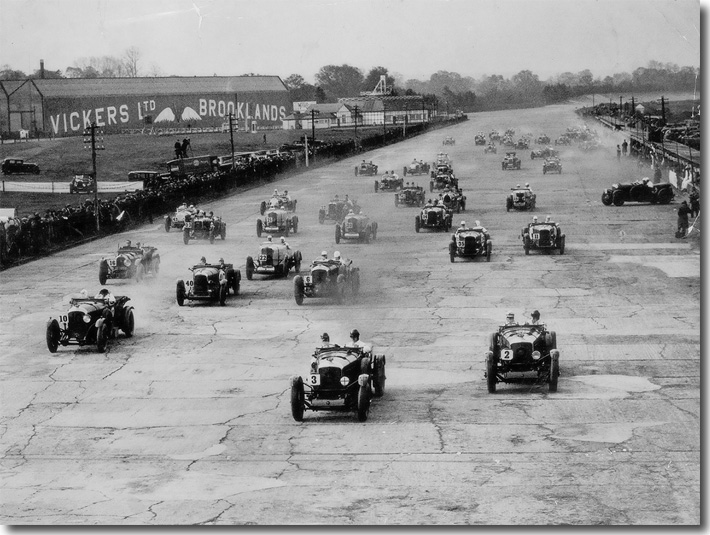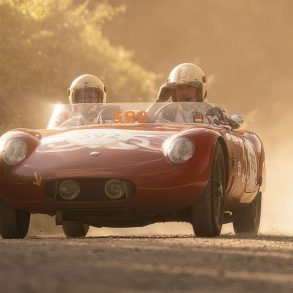Motor Racing History – Early Racecourse Development
Racing on public roads was illegal in England and British drivers had to resort to racing in Ireland or on the continent. The British motor industry suffered as a consequence. In response to this a group of wealthy enthusiasts led by Hugh F. Locke-King planned a race track to be built on his property in Surrey. Experienced race driver and car dealer, 29 year old Charles Jarrott suggested a very large high speed track. Selwyn Edge, whose London based Motor Power Company held the agency for Napier cars, was keen that the cars should be visible to the spectators for as much of the circuit as possible.
The conclusion was that the track would have to be banked, 100 feet wide and nearly 30 feet high in places. For nine months over seven hundred men worked almost around the clock for seven days a week, the only breaks being on Saturday and Sunday nights. The river Wey was diverted, small holders were re-housed, thirty acres of woodland were felled and 350,000 cubic yards of earth were moved. Seven miles of rail track was laid and 200,000 tons of gravel and cement were brought in and cast to become the race track.
On Monday June 17th 1907 the track was officially opened with an informal lunch party in the clubhouse for the various motor and horse racing leading lights of the time, with many of the press in attendance. A long procession of road and racing cars left the clubhouse for an initial tour of the track headed by Ethel Locke-King in her Itala after which one make groups of cars went out to be followed by the sight of a Darracq which ran high up the banking achieving a top speed of about 90 mph!
While just over the fence on the public roads of England the speed limit was 20 mph. Handicap races were held which became as much a social event as an automobile race. In fact the races were organized more like horse races as drivers had to wear certain colors instead of having numbers on their cars. Bookmakers would organize wagers yet Brooklands did have some fantastic racing and served as a site for many speed record attempts.
Racing in Europe continued on closed public roads but these were not profitable as it was impossible to charge any entrance fee, besides the races were very dangerous do to lack of crowd control. The situation was much the same in the America. More and more states were enacting laws that prohibited the use of highways for racing purposes. Four Indianapolis businessmen pooled their resources and built a two and a half mile oval, originally of crushed stone and asphalt but subsequently resurfaced with brick.
The 1920s saw the advent of shorter specially built circuits throughout Europe. In 1922 the Italian Grand Prix was held at one of these new tracks, the Autodromo Monza. Work began on May 15th with completion date set for August 15th: 3,500 workers, 200 wagons, 30 lorries, and a narrow gauge railway 5 kilometers (3.1 mi) long with 2 locomotives and 80 cars were employed. The autodrome was completed in the record time of 110 days and the track was entirely covered for the first time on July 28th by Petro Bordino and Felice Nazzaro in a Fiat 570.
The circuit conceived by Alfredo Rosselli included a high-speed loop with a total length of 4.5 kilometers (2.79 mi) featuring two banked curves on an embankment rising 2.6 meters (8.5 ft) above surrounding terrain. The road and speed tracks intersected on two levels with an underpass in the Serraglio zone. For its inaugural race 100,000 spectators poured through its gates. The event became a Fiat parade when many of the other manufactures pulled out with Bordino winning over Nazzaro. The French Grand Prix held later that year, on closed roads near Strasbourg, where it was Nazzaro’s turn to win.
1925 saw a number of developments. New road racing circuits were being built throughout Europe including Miramas, near Marseilles and Spa-Francorchamps in Belgium. Riding mechanics were banned as they had been in America. The first World Championship was organized and included the French, Italian and Belgian Grand Prix and the Indianapolis 500. This championship was between manufactures rather than drivers. Alfa Romeo won that inaugural year and celebrated the victory by incorporating a laurel wreath into its badge. Unfortunately this also marked the high point for Grand Prix racing until the next decade. Because of escalating costs and few perceived benefits most of the major manufactures decided to abandon their factory racing efforts.












